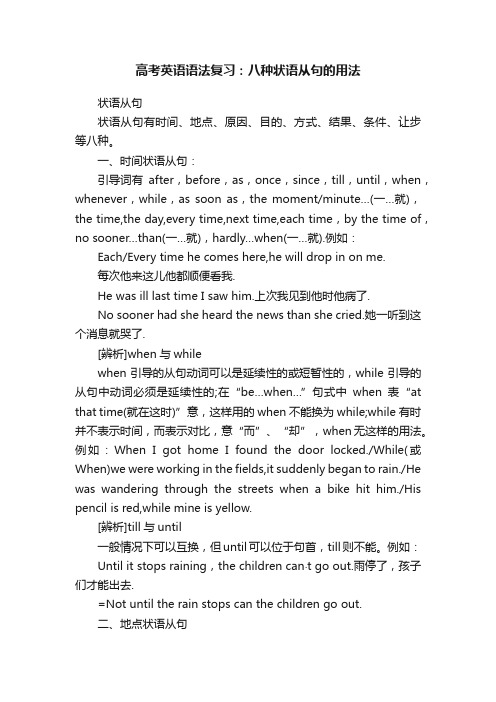高考英语语法:状语从句
- 格式:doc
- 大小:81.50 KB
- 文档页数:3


高考英语重要语法知识:状语从句定义:在句中作状语的从句是状语从句,修饰主句中的动词、形容词或副词等。
状语从句由从属连词引导,从属连词在句中不充当句子成分,只起连接作用,状语从句放在句首时,要用逗号,放在句尾时不用。
分类:根据意义上的不同,状语从句可分为:①时间状语从句②地点状语从句③原因状语从句④目的状语从句⑤条件状语从句⑥结果状语从句⑦让步状语从句⑧方式状语从句⑨比较状语从句一、时间状语从句引导时间状语从句的连词有:as, when(whenever),while, before, after, as soon as, until(till), since,every/each/next time, once.( as, when, while都有“当……的时候”,可以互用)◆When、While、as的区别:①when是at or during the time ,既指时间点,也可指一段时间,因此when引导的时间状语从句中的动词可以是终止性动词,也可以是延续性动词;while是during the time,只指一段时间,所以while从句中的动词必须是延续性动词。
②when说明从句的动作和主句的动作可以是同时,也可以是先后发生;when从句多用一般过去时while主从句动作或状态同时发生。
while从句多用过去进行时eg. When the teacher came in,we_____________________(talk).When the clock struck twelve,all the lights went out.When we arrived at the station,the train had left.While we _____________(have)supper,all the lights went out.While I was writing letters last night,he was watching TV.④when和while还可作并列连词when表示“就在那时”; while表示“然而”,表前后意思的对比。


高考英语语法复习:八种状语从句的用法状语从句状语从句有时间、地点、原因、目的、方式、结果、条件、让步等八种。
一、时间状语从句:引导词有after,before,as,once,since,till,until,when,whenever,while,as soon as,the moment/minute…(一…就),the time,the day,every time,next time,each time,by the time of,no sooner…than(一…就),hardly…when(一…就).例如:Each/Every time he comes here,he will drop in on me.每次他来这儿他都顺便看我.He was ill last time I saw him.上次我见到他时他病了.No sooner had she heard the news than she cried.她一听到这个消息就哭了.[辨析]when与whilewhen引导的从句动词可以是延续性的或短暂性的,while引导的从句中动词必须是延续性的;在“be…when…”句式中when表“at that time(就在这时)”意,这样用的when不能换为while;while有时并不表示时间,而表示对比,意“而”、“却”,when无这样的用法。
例如:When I got home I found the door locked./While(或When)we were working in the fields,it suddenly began to rain./He was wandering through the streets when a bike hit him./His pencil is red,while mine is yellow.[辨析]till与until一般情况下可以互换,但until可以位于句首,till则不能。

2.(2024课标卷)34. You have to move out of the way the truck cannot get past you.A. soB. orC. andD. but【答案】B【解析】考查并列连词。
上下文存在着逻辑上的条件关系,所以用“or”意为“否则的话”。
句意:你得挪一挪位置,否则卡车过不去。
4.(2024北京卷)21.—Look at those clouds!—Don’t worry. ______ it rains, we’ll still have a great time.A. Even ifB. As thoughC. In caseD. If only【答案】A【解析】考查状语从句。
even if 即便,as though好像,in case 以防,if only要是…...多好啊。
句意:—看看那些云!—不用担忧。
即使下雨,我们也会玩得很快乐的。
5.(2024天津卷)14.Everything was placed exactly ___________he wanted it for the graduation ceremony.A. whileB. whenC. whereD. though【答案】C【解析】考查状语从句。
地点状语从句。
句意:毕业典礼所须要的东西都被放在了他想放的地方了。
7.(2024上海卷)40.The map is one of the best tools a man has _ _ he goes to a new place.A. wheneverB. whateverC. whereverD. however【答案】A【解析】考查状语从句。
从句中有“地点a new place”作宾语,故解除BC选项。
很明显本句是时间状语从句。
句意:一个人无论什么时候到了一个新地方,地图就是他运用的最好的工具之一。
8.(2024重庆卷) 30.—Coach, can I continue with the training?—Sorry, you can’t ______you haven’t recovered from the knee injury.A. untilB. beforeC. asD. unless【答案】C【解析】考查状语从句。

2024年高中英语语法学习之状语从句精讲英语状语从句是英语学习中的一个重要考点,下面将针对英语状语从句进行考点归纳。
一、时间状语从句时间状语从句是语法中的一个重要考点,下面是一些常见的时间状语从句: when:表示某个时间点或时间段,如“I will arrive at the airport when the plane takes off.”before:表示某个时间点或时间段之前,如“I will eat breakfast before I go to work.”after:表示某个时间点或时间段之后,如“I will finish my homework after I have dinner.”while:表示某个时间点或时间段持续,如“I was studying while she was sleeping.”as soon as:表示某个时间点或时间段一过去就发生,如“I will call you as soon as I get home.”until:表示某个时间点或时间段一直持续,如“I won't leave until I have finished my work.”since:表示某个时间点或时间段以来,如“I have been living in this city since I moved here last year.”when/while/as:这些词都可以引导时间状语从句,但它们的使用略有不同,需要根据具体语境选择使用哪个。
需要注意的是,如果主句是一般将来时,从句只能用一般现在时,如“I will go to the store tomorrow”中的“tomorrow”就是时间状语从句。
二、地点状语从句地点状语从句是语法中的一个重要考点,下面是一些常见的地点状语从句: where:表示某个地点,如“I will go to the store where I bought the groceries.”that:表示某个地点或位置,如“I saw a beautiful sunset over that mountain.”which:表示某个地点或位置,如“The building which is on fire needs to be evacuated immediately.”where/that/which:这些词都可以引导地点状语从句,但它们的使用略有不同,需要根据具体语境选择使用哪个。
高考英语状语从句语法知识点梳理(名师总结基础语法知识点,值得下载)结构图概述时间状语从句的用法:1、2、3、4、5、6、7状语从句 地点状语从句的用法:原因状语从句的用法:1、2、3、4 条件状语从句的用法:1、2用法 方式状语从句的用法:让步状语从句的用法:1、2、3目的状语从句的用法:结果状语从句的用法:1、2、3 比较状语从句的用法:1、2、3、4、5、6一、概述:状语从句修饰主句中的动词、形容词、副词等,在复合句中作状语。
引导状语从句的关联词是从属连词。
状语从句用陈述句语序,一般位于复合句的句首或句末。
当从句放在主句前面时,常用逗号与主句隔开。
状语从句根据其在句中的不同作用可以分为时间、地点、原因、目的、结果、条件、让步、方式和比较状语从句九种。
二、用法:(一)时间状语从句的用法:1、注意点:⑴在时间、条件状语从句中,谓语动词一般不用将来时态表示将来,而用一般现在时态代替将来时态,用一般过去时态代替过去将来时态,用现在完成时态代替将来完成时态。
如:When he comes here,I will let you know. When I have finished reading the book,I will tell you.⑵if可以引导条件状语从句和宾语从句,引导条件状语从句时,意为“如果,假如”,引导宾语从句时,意为“是否”。
如:If he has any questions,he will come to ask me. Tell me if you will go to school tomorrow.⑶时间、条件、方式、让步等状语从句常常可以转换成省略形式或简单句句子成分。
①when,while,as,if,though,as if等引导时间、条件、方式、让步等状语从句时,若从句和主句的主语一致或主句的主语是it且含有be动词时,可以将从句中的主语连同后面的be动词一起省略。
高考英语状语从句的用法归纳一、概说状语从句即指在主从复合句用作状语的从句。
按照其意义,状语从句可分为时间状语从句、地点状语从句、原因状语从句、目的状语从句、结果状语从句、条件状语从句、让步状语从句等。
状语从句是高中英语学习中的一个语法重点,也是历年高考重点考查的内容之一。
学习状语从句主要应注意引导状语从句的从属连词的用法与区别,以及从属连词在一定的语言环境中的意义与用法。
二、时间状语从句1. 引导时间状语从句的从属连词很多,常见的有before, after, when, while, as, since, till, until, as soon as 等。
2. 表示“当…时候”的 while, when, as 的用法区别是:while从句中的谓语动词必须是延续性动词;表示带有规律性的“每当”或当主、从句谓语动词的动作发生有先后时,只能用 when;当表示“一边…一边…”或“随着”时,只能用 as。
另外,用于此义的 as 所引导的时间状语从句谓语只能是动作动词,不能是状态动词。
如下面一道高考题的答案是 B 而不能是A:“I’m going to the post office.” “_____ you’re there, can you get me some stamps?”A. AsB. WhileC. BecauseD. If3. until 在肯定句中通常只连用延续性动词,表示相应动作结束的时间;在否定句中通常连用非延续性动词,表示相应动作开始的时间,意为“直到…才”。
如:He waited until she was about to leave. 他等着一直到她准备离开。
I did not begin to work till he had gone. 他走了后我才开始工作。
4. 表示“一…就”除用 as soon as 外,还可用 the minute, the second, the instant, immediately, directly, instantly, no sooner…than, hardly…when 等。
高考英语语法:状语从句
一.定义: 在句中作状语的从句就叫做状语从句
二.分类: 状语从句包括以下八类
1.时间状语从句: 由when, while, as, before, after, since, till / until, as soon as等引导
a. I shall tell him the good news when he comes.
2.原因状语从句: 由because, as, since, for等引导
a. He didn’t hear me because he was listening to the radio.
b. Since you are free today, you had better show me how to use the computer.
3.地点状语从句: 由where等引导
a. Please put the book where it was after you finish reading it.
4.条件状语从句: 由if, unless等引导
a. I will come to see you if I have time on Sunday.
5.比较或方式状语从句: 由than, as, as if, as...as...等引导
a. I know you do better th an he does.
b. The old worker runs very fast as if he were a young man.
6.目的状语从句: 由so that, in order that等引导
a. They set out early so that they could arrive at the station in good time.
7.结果状语从句: 由so, so that, so / such...that...等引导
a. They set out early so that they arrived at the station in good time.
b. He finished his work so well that the boss praised him in publi
c.
8.让步状语从句: 由though / although, even if, whatever, whoever, whenever, no matter what / who等引导
a. He is in very good health though he is old.
b. They didn’t stop working even if it began to rain hard.
三.应注意的问题:
1.时间和条件状语从句中常用一般时代替将来时
a. I will go and see a film if I have time tomorrow.
b. I will tell the about it as soon as he comes back.
c. He said he would go out for a walk when he finished his work.
2.状语从句中可有省略: 在一个含有状语从句的复合句中, 如果主句和状语从句的主语相同, 或状语从句的主语是it, 并且状语从句的谓语含有be动词时, 可以将状语从句的主语和be 一起省略掉
a. As (she was ) a child, she began to learn English.
b. If ( he was ) al ive, he must be at least ninety years old.
c. Althou gh ( he was ) told to stop, he kept on working.
d. If ( it is) necessary, ring me up.
e. He didn’t say a single word unti l ( he was ) asked.
3.as和than引导的比较状语从句中, 从句中和主句中相同的部分往往省略, 从句中只剩下比较对象
a. He is a head taller than I ( am tall ).
than之后的人称代词是主格或宾格时, 有时意思不同, 如:
a. She likes the dog more than me.=She likes the dog more than she likes me.她喜欢狗比喜欢我更多
b. She likes the dog more than I.=She likes the dog more than I like the god. 她比我更喜欢狗
4.含有no soonerthan和hardly / barely / scarcely when的句子相当于含有as soon as引导的时间状语的句子.no sooner或hardly放在句首时, 主谓要部分倒装
a. He had no sooner seen the policem an than he ran away. =No sooner had he seen the p oliceman than he ran away. =He ran away as soon as he saw the policemen.
b. He had hardly sat down when the telephone rang. =Hardly had he sat down when the telephone rang. =The telephone rang as soon as he sat down.
5.immediately, directly, instantly等词也可以作为连词引导时间状语从句, 相当于as soon as引导的时间状语
a. I went to see him immediately I heard from him. =I went to see him as soon as I heard from him.
6.the moment, the minute, the second引导时间状语从句, 相当于as soon as引导的时间状语
a. He let out a cry the moment he saw the snake.=He let out a cry as soon as he saw the snake.
7.each time, every time, any time, last time, next time, first time可以引导时间状语从句
a. They shake hands with each other each time they meet.
8.since引导的时间状语从句中, 若谓语动词是延续性动词或状态动词, 则其过去时表示动作的完成或状态的结束
a. It is five years since he lived here. 他不住这里己有五年了
a. They shake hands with each other each time they meet.
8.since引导的时间状语从句中, 若谓语动词是延续性动词或状态动词, 则其过去时表示动作的完成或状态的结束
a. It is five years since he lived here. 他不住这里己有五年了。